Centrosome biogenesis continues in the absence of microtubules during prolonged S-phase arrest
- PMID: 20458743
- PMCID: PMC2930098
- DOI: 10.1002/jcp.22222
Centrosome biogenesis continues in the absence of microtubules during prolonged S-phase arrest
Abstract
When CHO cells are arrested in S-phase, they undergo repeated rounds of centrosome duplication without cell-cycle progression. While the increase is slow and asynchronous, the number of centrosomes in these cells does rise with time. To investigate mechanisms controlling this duplication, we have arrested CHO cells in S-phase for up to 72 h, and coordinately inhibited new centriole formation by treatment with the microtubule poison colcemid. We find that in such cells, the pre-existing centrosomes remain, and a variable number of foci--containing alpha/gamma-tubulin and centrin 2--assemble at the nuclear periphery. When the colcemid is washed out, the nuclear-associated foci disappear, and cells assemble new centriole-containing centrosomes, which accumulate the centriole scaffold protein SAS-6, nucleate microtubule asters, and form functional mitotic spindle poles. The number of centrosomes that assemble following colcemid washout increases with duration of S-phase arrest, even though the number of nuclear-associated foci or pre-existing centrosomes does not increase. This suggests that during S-phase, a cryptic generative event occurs repeatedly, even in the absence of new triplet microtubule assembly. When triplet microtubule assembly is restored, these cryptic generative events become realized, and multiple centriole-containing centrosomes assemble.
(c) 2010 Wiley-Liss, Inc.
Figures
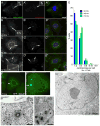


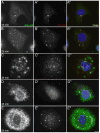
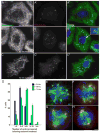
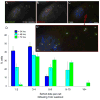
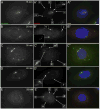

Similar articles
-
Centrosome replication in hydroxyurea-arrested CHO cells expressing GFP-tagged centrin2.J Cell Sci. 2007 Jul 15;120(Pt 14):2444-53. doi: 10.1242/jcs.008938. J Cell Sci. 2007. PMID: 17606999
-
Dissociation of centrosome replication events from cycles of DNA synthesis and mitotic division in hydroxyurea-arrested Chinese hamster ovary cells.J Cell Biol. 1995 Jul;130(1):105-15. doi: 10.1083/jcb.130.1.105. J Cell Biol. 1995. PMID: 7790366 Free PMC article.
-
Role for microtubules in centrosome doubling in Chinese hamster ovary cells.Cell Motil Cytoskeleton. 1999;42(1):60-72. doi: 10.1002/(SICI)1097-0169(1999)42:1<60::AID-CM6>3.0.CO;2-7. Cell Motil Cytoskeleton. 1999. PMID: 9915585
-
Construction of centrosomes and spindle poles by molecular motor-driven assembly of protein particles.Traffic. 2000 Dec;1(12):927-34. Traffic. 2000. PMID: 11208082 Review.
-
Big Lessons from Little Yeast: Budding and Fission Yeast Centrosome Structure, Duplication, and Function.Annu Rev Genet. 2017 Nov 27;51:361-383. doi: 10.1146/annurev-genet-120116-024733. Epub 2017 Sep 15. Annu Rev Genet. 2017. PMID: 28934593 Review.
Cited by
-
Centriolar satellite- and hMsd1/SSX2IP-dependent microtubule anchoring is critical for centriole assembly.Mol Biol Cell. 2015 Jun 1;26(11):2005-19. doi: 10.1091/mbc.E14-11-1561. Epub 2015 Apr 1. Mol Biol Cell. 2015. PMID: 25833712 Free PMC article.
-
Centriole duplication: analogue control in a digital age.Cell Biol Int. 2010 Dec;34(12):1239-45. doi: 10.1042/CBI20100612. Cell Biol Int. 2010. PMID: 21067522 Free PMC article. Review.
-
Apparent diffusive motion of centrin foci in living cells: implications for diffusion-based motion in centriole duplication.Phys Biol. 2011 Apr;8(2):026010. doi: 10.1088/1478-3975/8/2/026010. Epub 2011 Mar 4. Phys Biol. 2011. PMID: 21378439 Free PMC article.
-
Principal Postulates of Centrosomal Biology. Version 2020.Cells. 2020 Sep 24;9(10):2156. doi: 10.3390/cells9102156. Cells. 2020. PMID: 32987651 Free PMC article. Review.
-
One to only two: a short history of the centrosome and its duplication.Philos Trans R Soc Lond B Biol Sci. 2014 Sep 5;369(1650):20130455. doi: 10.1098/rstb.2013.0455. Philos Trans R Soc Lond B Biol Sci. 2014. PMID: 25047609 Free PMC article. Review.
References
-
- Balczon R, Varden CE, Schroer TA. Role for microtubules in centrosome doubling in Chinese hamster ovary cells. Cell Motil Cytoskeleton. 1999;42:60–72. - PubMed
-
- Bettencourt-Dias M, Glover DM. Centrosome biogenesis and function: centrosomics brings new understanding. Nat Rev Mol Cell Biol. 2007;8:451–463. - PubMed
-
- Bettencourt-Dias M, Rodrigues-Martins A, Carpenter L, Riparbelli M, Lehmann L, Gatt MK, Carmo N, Balloux F, Callaini G, Glover DM. SAK/PLK4 is required for centriole duplication and flagella development. Curr Biol. 2005;15:2199–2207. - PubMed
Publication types
MeSH terms
Substances
Grants and funding
LinkOut - more resources
Full Text Sources

